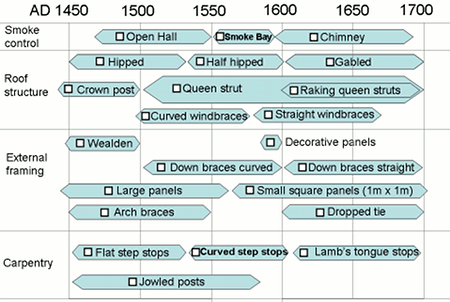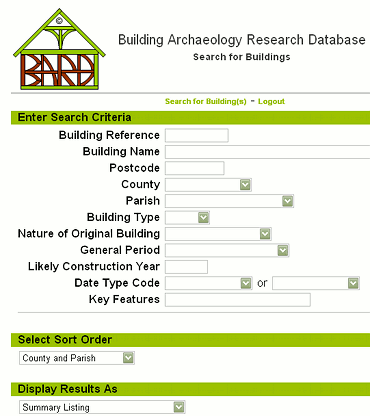
An internet-accessible Building Archaeological Research Database (BARD)
What is BARD?
- BARD is a non-profit-making internet-based building archaeology research database, aimed at further developing the age estimation of timber-framed and brick buildings.
- It provides an easy-to-use method for recording the key features in buildings. Because these key features have known date ranges, they help to narrow down the date of construction of a building.
- BARD not only helps you date your home, but it also contributes to our knowledge of how different building styles developed through the centuries and across regions.
- BARD has been developed in a partnership between the Domestic Building Research Group (Surrey) and Tree-Ring Services. Any profit is reinvested in its further development and research.
How does BARD work?
From our knowledge of buildings that have already been dated, we know the typical date ranges for some building archaeological features. BARD lets users record and compare these archaeological features for their own house (or other building) on an easy-to-use tick-sheet, allowing the likely date of construction to be narrowed down.
You can use the building archaeology database in 3 main ways:
- Search for a building(s)
- Add a building
- Update a building
The first two can be done on the initial search screen; the third is available at the foot of the specific building tick-sheet display once you have made changes.
What are the advantages of BARD?
BARD uniquely combines the ability to enter, update, search, summarise and archive data on both timber-framed and brick buildings (up to the mid-19th century), all online. A particularly useful feature is the searchable free-form text field, which can be used to record and search for "key" features (such as open-hall houses or queen post roofs), or other features of research interest.
A second unique feature of BARD is the "Tick-box" recording sheet. The "Tick-box" sheet provides a systematic way of recording the stylistic features in buildings and, because the common date ranges of "key" features are shown, it also helps in the dating of a building during its recording. A much simplified version of the "Tick-box" sheet, showing some of the stylistic features that can be 'ticked' and their approximate date ranges, is shown below:

Not sure what a queen strut looks like?
To help you understand the terms used in the "Tick-box" sheet, you can download an illustrated glossary of building features. To ensure common nomenclature, the Council for British Archaeology's (CBA) illustrated glossary of timber-framing terms has generally been used, and this book provides a useful and extensive guide to features in timber-framed buildings.
As long as you have internet access, you can instantly upload survey data and compare and share it easily. All users are able to search the database, but the ability to add, amend and edit records is usually restricted to your own data.
How do I use BARD?
You can search building records online using any combination shown on the search screen menu (below - Date type refers to tree-ring, date stone, documentary and graffito).

The results of any search may be displayed online either as a summary listing or as key features in tabular form. Both these listings can be produced by county/parish/building name order, or by likely construction date. From either listing, the building name is a hyperlink that takes you to the individual record for that building. You can also print the results. Small thumbnail pictures or drawings of buildings are shown (where available) on the individual building Tick-box sheet and the summary listing.
What else can BARD do?
We encourage users to import existing datasets onto BARD and to publish their analyses. Distribution histograms, mapping of features, and other analysis can be provided offline, by separate agreement, as can data segments in either Microsoft Excel or Access format. As the database continues to expand, it is likely that new data fields will be added to help widen research and include regional variations.
How do I subscribe to BARD?
For all queries and further information on how to subscribe to BARD, please e-mail the database manager, Andy Moir (akmoir@tree-ring.co.uk).
Further details on BARD are also available in: Moir, A K, Wild, R, and Haddlesey, R, 2012 An Internet-Accessible Building Archaeology Research Database (BARD), Vernacular Architecture, 43, 1-6. A copy of this paper is available on request.
Updated: 17/10/2013




